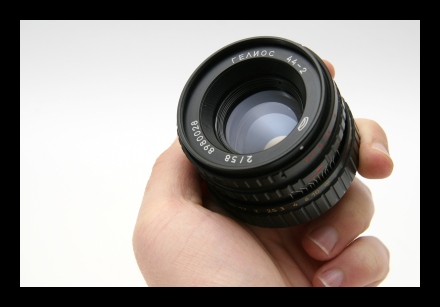


You also need to move a lever at the base of the lens. Changing the aperture setting won't actually close the aperture. I also have to plug rangefinders where this is never an issue because you never look through the lens. Before cameras added automation that could do this action for you. This is what people in the olden days did. When you're ready to take the photo you can quickly rotate this ring which will close the aperture down to your "preset" setting. That will let the most light in the viewfinder making it brighter and easier to see through. If you're wondering why such a design exists then it's to allow for focussing / framing with wide open aperture. Preset lenses can seem weird in the beginning. The actual ring to open / close the aperture is very light in action and feels good in use. Helios-44-2, with the preset aperture, has more dampened and less defined "clicks". The "more normal" Helios-44M-5 has a regular aperture ring and has the best "clicks". Focusing ring turns with a nice resistance and, if you ignore the movements in other dimensions, actually feels nice.Īperture clicks are definite, with a good click in them. I'm sure there are copies where this is not true but that shouldn't be the norm. The metal feels nicer in the hands than the rough plastic.įocussing action is quite smooth and pleasant. I definitely prefer the older, metal versions like the Helios-44-2. They are weak and can break if you look at them the wrong way. If you attempt to screw those lenses - be careful. They can come loose which will enhance the wobbliness. The screws used to hold together the lens are also lacking in strength. You can expect some play between the various parts of the lens. It doesn't matter if the lens is made from metal or plastic. If you live in a former Soviet Union country then you might find this lens given away as paper-weight.

Some versions or sellers that have confirmed that the lens is not terrible might cost more. Unless you live in a former Soviet Union country, you can expect to pay around $50 for this lens. You have a ring that will allow you to switch between wide open and your chosen aperture with one smooth motion. It's an older lens that is all metal and has a preset aperture design. At least as long as the camera supports it. It's a black, plastic lens that will allow the camera to automatically stop the lens down as you're taking a photo. I got it a very long time ago together with Zenit 130. There is a wild mix between good and bad copies. If you get a copy that you think performs badly, try a different one. Later Helios-44 versions have a more "normal" rendering although the core characteristics are still there.Īs is true for most soviet camera gear ( and also non-camera ), there can be a huge sample variation in play. The optical rendering will be close to earlier Helios-44 versions. If you have a chance to get a Biotar - do it. It's based on Carl Zeiss Biotar 58mm f2 lens. Helios-44, as many other soviet items, is not an original design. Later versions are said to have more resolving power but in practice early versions seem to be better. I have my preferences but for the most part it doesn't matter which lens version is used. Optical formula, aperture blade count and other functionality is variable between the different versions but the differences won't significantly impact the performance or ease of use.


 0 kommentar(er)
0 kommentar(er)
